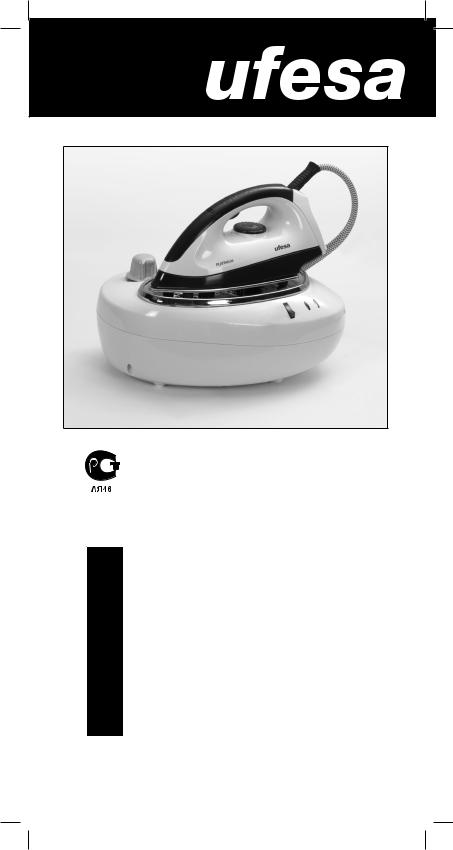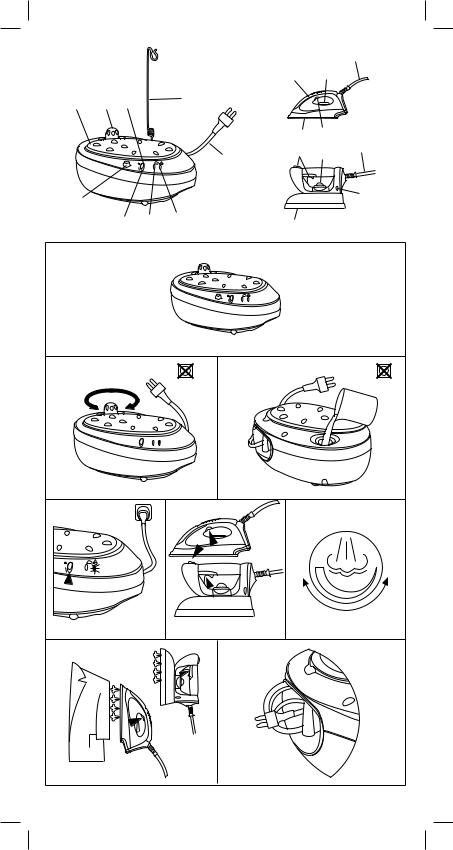Ufesa PL1382, PL1381, PL1380 Manual

PL1380
PL1381
PL1382
ES INSTRUCCIONES DE USO GB OPERATING INSTRUCTIONS FR MODE D'EMPLOI
PT INSTRUÇÕES DE USO
DE GEBRAUCHSANLEITUNG HU HASZNÁLATI UTASÍTÁS
RU РУKОВОДСТВО ПО ЭКСПЛУАТАЦИИ
CZ NÁVOD K POUÎITÍ
RO INSTRUCTIUNI DE FOLOSIRE
AR ﻞﻴﻐﺸﺘﻟا تادﺎﺷرإ
1380/81/82.indd 1 |
3/10/06 16:05:2 |

|
|
|
|
|
|
|
|
13 |
|
|
|
|
|
|
11 |
12 |
|
2 |
3 |
4 |
|
|
5 |
|
|
|
|
|
|
|
|
|
|||
|
|
|
|
|
|
9 |
8 |
|
|
|
|
|
|
14 |
8 |
12 |
13 |
|
|
|
|
|
|
|||
|
|
|
|
|
|
|
|
|
15 |
|
|
|
|
|
|
|
11 |
|
|
|
|
|
|
|
|
|
|
|
1 |
7 |
6 |
|
10 |
|
|
Fig. 1
Fig. 2 |
Fig. 3 |
Max |
Min |
Fig. 4 |
Fig. 5 |
Fig. 6 |
Fig. 7 |
Fig. 8 |
1380/81/82.indd 2 |
3/10/06 16:05:2 |

ES |
|
GB |
FR |
|
|
1. |
Interruptor |
1. |
Switch |
1. |
Interrupteur |
2. |
Reposaplancha |
2. |
Iron-Rest |
2. |
Repose-fer |
3. |
Tapón de llenado |
3. |
Filling cap |
3. |
Bouchon de remplissage |
4. |
Piloto caldera |
4. |
Boiler pilot lamp |
4. |
Voyant générateur |
5. |
Varilla cable plancha |
5. |
Iron cable support-rod |
5. |
Guide-fil du fer |
6. |
Piloto vapor |
6. |
Steam pilot lamp |
6. |
Voyant vapeur |
7. |
Piloto falta de agua |
7. |
Lack of water pilot lamp |
7. |
Voyant manque d’eau |
8. Pulsador vapor |
8. Steam push-button |
8. Bouton vapeur |
|||
9. |
Base de inoxidable |
9. |
Stainless steel base |
9. |
Semelle inoxydable |
10. |
Base de aluminio pulido |
10. |
Polished aluminium sole |
10. |
Base en aluminium poli |
11. |
Piloto plancha |
11. |
Iron pilot lamp |
11. |
Voyant fer |
12. |
Regulador de temperatura |
12. |
Temperature regulator |
12. |
Régulateur température |
13. |
Conexión plancha |
13. |
Iron connection |
13. |
Connexion fer |
14. |
Conexión red |
14. |
Mains supply connection |
14. |
Connexion réseau |
15. |
Regulador de vapor (PL1382) |
15. |
Steam regulator (PL1382) |
15. |
Régulateur de vapeur (PL1382) |
PT |
|
RU |
|
DE |
|
1. |
Interruptor |
1. Переключатель |
1. |
Unterbrecher |
|
2. |
Repousa-ferro |
2.Подставка для утюга |
2. |
Bügeleisen-Abstellvorrichtung |
|
3. |
Tampão de enchimento |
3.Крышка наполнения |
3. |
Füllstopfen |
|
4. |
Lâmpada-piloto caldeira |
4.Контрольная лампочка генератора |
4. |
Anzeigelampe Dampferzeuger |
|
5. |
Vareta cabo ferro de engomar |
|
пара |
5. |
Kabelstange Bügeleisen |
6. Lâmpada-piloto vapor |
5.Стержень электрошнура утюга |
6. Anzeigelampe Dampf |
|||
7. |
Lâmpada-piloto falta de água |
6.Контрольная лампочка подачи пара |
7. |
Anzeigelampe für Wassermangel |
|
8. Botão vapor |
7. Контрольная лампочка |
8. Dampftaste |
|||
9. |
Base inoxidável |
|
необходимости добавления воды |
9. |
Rostfreie Sohle |
10. |
Base de alumínio polido. |
8.Кнопка подачи пара |
10. |
Sohle aus glanzpoliertem |
|
11. |
Lâmpada-piloto ferro de engo- |
9.Основание из нержавеющей стали |
|
Aluminium |
|
|
mar |
10. Основание из полированного |
11. |
Anzeigelampe Bügeleisen |
|
12. |
Regulador de temperatura |
|
алюминия |
12. |
Temperaturregler |
13. |
Ligação ferro de engomar |
11. Контрольная лампочка утюга |
13. |
Anschluss Bügeleisen |
|
14. |
Ligação rede |
12. Регулятор температуры |
14. |
Netzanschluss |
|
15. |
Regulador de vapor (PL1382) |
13.Соединительный электрошнур утюга |
15. |
Dampfregler (PL1382) |
|
|
|
14. Соединительный электрошнур к сети |
|
|
|
|
|
15. Регулятор подачи пара (PL1382) |
|
|
|
HU |
|
RO |
CZ |
|
|
1. |
Kapcsoló |
1. |
Întrerupãtor |
1. |
Spínaã |
2. |
Vasalótartó |
2. |
Loc sprijin fier cãlcat |
2. |
Odkladná plocha |
3. |
MegtöltŒ nyílás teteje |
3. Dop de umplere |
3. |
Plnicí uzávûr |
|
4. |
A vízmelegítŒ ellenŒrzŒ lámpája |
4. |
Semnal luminos cãldare |
4. |
Kontrolka kotlíku |
5. |
Vasalókábel tartó rudacska |
5. |
Spitã cablu fier |
5. |
Svorka kabelu ÏÏehliãky |
6. |
A gŒzt jelzŒ ellenŒrzŒ lámpája |
6. |
Semnal luminos aburi |
6. |
Kontrolka napafiování |
7. |
A vízhiányt jelzŒ ellenŒrzŒ |
7. |
Semnal luminos lipsa apei |
7. |
Kontrolka chybûjící vody |
|
lámpája |
8. |
Buton abur |
8. |
Tlaãítko pro napafiování |
8. |
GŒzt kilökŒ gomb |
9. |
Bazã inoxidabilã |
9. |
Nerezová Ïehlicí deska |
9. |
Rozsdamentes talp |
10. |
Bazã de aluminiu lustruit |
10. |
Îehlicí plocha z le‰tûného hliníku |
10. |
Csiszolt alumínium talp |
11. |
Semnal luminos fier cãlcat |
11. |
Kontrolka Ïehliãky |
11. |
A vasaló ellenŒrzŒ lámpája |
12. |
Regulator de temperaturã |
12. |
Ovladaã teploty |
12. |
HŒmérsékletszabályozó |
13. |
Conexiune fier cãlcat |
13. |
Zapojení Ïehliãky |
13. |
Vasaló kábel |
14. |
Conexiune retea |
14. |
Zapojení do sítû |
14. |
Hálózati kábel |
15. |
Regulator de abur (PL1382) |
15. |
Régulator páry ( PL1382) |
15. |
GŒzlöket szabályozó (PL1382) |
|
|
|
|
ﻞﻴﻐﺸﺗ ﺭﺯ |
.1AR |
ﺓﺍﻮﻜ ﺍ ﺀﺎﻜﺗﺇ ﻖﻓﺮﻣ |
.2 |
ﺀﻼﺘﻣﻹﺍ ﺓﺩﺍﺪﺳ |
.3 |
ﺭﺎﺨﺒﻟﺍ ﺪﻟﻮﻣ ﻞﻴﻟﺩ |
.4 |
ﻲﺋﺎﺑﺮﻬﻜﻟﺍ ﻂﻴ ﺍ ﺾﺒﻘﻣ .5 |
|
ﺓﺍﻮﻜﻤﻠﻟ |
|
ﺭﺎﺨﺒﻟﺍ ﺪﻴﻟﻮﺗ ﻞﻴﻟﺩ .6 |
|
ﺀﺎ ﺍ ﺫﺎﻔﻧ ﻞﻴﻟﺩ .7 |
|
ﺭﺎﺨﺒﻟﺍ ﺪﻴﻟﻮﺗ ﺭﺯ .8 |
|
ﺪﺴﻛﺄﺘﻠﻟ ﺔﻠﺑﺎﻗ ﺮﻴﻏ ﺓﺪﻋﺎﻗ .9 |
|
ﻝﻮﻘﺼﻣ ﻡﻮﻴﻨ ﺃ ﺓﺪﻋﺎﻗ |
.10 |
ﺓﺍﻮﻜ ﺍ ﻞﻴﻟﺩ |
.11 |
ﺓﺭﺍﺮ ﺍ ﻝﺪﻌﻣ |
.12 |
ﺓﺍﻮﻜﻤﻠﻟ ﻲﺋﺎﺑﺮﻬﻜﻟﺍ ﻂﺑﺮﻟﺍ |
.13 |
ﺭﺎﻴﺘﻠﻟ ﻲﺋﺎﺑﺮﻬﻜﻟﺍ ﻂﺑﺮﻟﺍ |
.14 |
(PL1382)ﺭﺎﺨﺒﻟﺍ ﻝﺪﻌﻣ |
.15 |
1380/81/82.indd 3 |
3/10/06 16:05:2 |

ESPAÑOL
CONEXIÓN A LA RED
Conéctese únicamente a la tensión indicada en la placa de características. Es recomendable un enchufe con toma de tierra.
NOTAS IMPORTANTES
•Lea detenidamente las instrucciones de uso
•No desatender el generador de vapor mientras esté conectado a la red.
•Se recomienda vigilar el aparato cuando se usa cerca de los niños.
•La plancha tiene que utilizarse y colocarse sobre una superficie estable.
•Cuando se coloque sobre su soporte, asegurarse de que la superficie sobre la que se coloca el soporte es estable.
•No ha de utilizar la plancha si se ha caído, si hay señales visibles de daño o si existe fuga de agua, hay que hacerla revisar por el Servicio Técnico Autorizado antes de volverla a usar.
•En las pausas de planchado deje el aparato sobre el Reposaplanchas
•No deje nunca la plancha caliente sobre textiles o materiales que puedan quemarse fácilmente.
•No coloque la plancha sobre el cable de conexión
•No use la caldera si el cable está deteriorado
•No introduzca la plancha ni la caldera en agua ni en líquido alguno
•Antes de llenar con agua la caldera desenchufe la clavija de la red.
•Al terminar de planchar desconecte la clavija de la red
•No desconecte tirando del cable, ni dejar la conexión colgando.
•El orificio de llenado no debe estar abierto durante el funcionamiento.
AGUA A UTILIZAR
Esta caldera está diseñada para planchar con agua corriente del grifo. Si el agua a utilizar es muy dura (superior a 17º HD) se recomienda mezclar con agua destilada o desmineralizada. No emplee agua de baterías.
PREPARACION
Comprobar siempre si la prenda tiene alguna etiqueta con instrucciones de planchado. Poner el mando del termostato (12) en la temperatura adecuada.
•Fibras sintéticas Temperatura baja
••Sedalana Temperatura media
•••Algodón-lino Temperatura alta
CONSEJOS DE UTILIZACION
Colocar siempre la caldera bien nivelada sobre una superficie estable
Durante el planchado, la plancha se debe colocar sobre el reposa-plancha, encima de la caldera Fig 1.
No apoye nunca la plancha sobre su talón (modelo de plancha profesional. Colóquela siempre en posición horizontal sobre el re- posa-planchas.
LLENADO DE LA CALDERA
•Desenchufar el aparato
•Desenroscar el tapón 3. Fig.2
•Llenar la caldera con agua del grifo con la ayuda de una jarra o botella. Fig. 3
•Volver a enroscar el tapón (3)
Ya puede poner la caldera en marcha. Con la caldera llena de agua, se dispone de una autonomía de aproximadamente 11/2 horas gracias a su capacidad de 1l.
• Como volver a llenar la caldera durante su utilización
Si es necesario volver a llenar la caldera, se deben realizar con cuidado las siguientes operaciones:
•Comprobar , apretando el pulsador de vapor (8) en la plancha, que ya no sale más vapor.
•Poner el interruptor de la caldera (1) en la posición de apagado.
•Desenroscar el tapón (3) lentamente hasta que salga todo el vapor residual que pudiera quedar.
•Desenchufar el aparato
•Volver a llenar la caldera.
•Colocar el tapón (3)
•Volver a enchufar el aparato
PUESTA EN MARCHA DEL APARATO
•Enchufar el aparato Fig. 4
•Pulsar el interruptor (1) de la caldera. El piloto se enciende y la caldera comienza a generar vapor.
La caldera estará lista para planchar cuando el piloto (6) se encienda (al cabo de unos 6 ó 7 minutos). Fig.4
Observaciones:
•Si el llenado de la caldera se realiza con agua caliente, estará lista para funcionar antes.
•Durante el planchado, la temperatura de la caldera y de la base de la plancha se regulan automáticamente. Los pilotos 6 y 11 se encienden y apagan periódicamente. Esto es normal.
•Cuando se enciende el indicador de falta de agua (7) en la caldera, hay que volver a llenar la caldera (ver apartado “Cómo llenar la caldera durante su utilización”).
PLANCHADO CON VAPOR
Después de realizada la operación “Puesta en marcha del aparato”.
• Apretar el pulsador (8) de la plancha para obtener un chorro de vapor. El vapor cesa en el momento en que se suelta el pulsador. Fig. 5.
1380/81/82.indd 4 |
3/10/06 16:05:2 |

REGULACION DEL CAUDAL DE VAPOR (Mod. PL1382)
Puede regularse el caudal de vapor que se desea para el planchado. Girando el mando regulador a la izquierda se reduce caudal de vapor y girando a la derecha se consigue el máximo caudal de vapor. (Fig. 6)
Es aconsejable no utilizar vapor por debajo de la posición del termostato de 2 puntos “••”.
DESARRUGADO VERTICAL
•Gire el regulador de temperatura (12) a la posición “MAX” y espere a alcanzar la temperatura
•Suspenda la prenda de una percha y sitúe la plancha a 10-20 cm de distancia. No planche nunca una prenda si esta se encuentra sobre una persona (Fig.6)
•Presione el gatillo de producción de vapor durante el tiempo que considere oportuno, y obtendrá un chorro continuo de vapor.
DISPOSITIVOS DE SEGURIDAD
Este aparato está equipado con los siguientes dispositivos de seguridad:
-En la plancha:
•un termofusible de seguridad que evita que se caliente en exceso
-En la caldera:
•una válvula de sobrepresión
•un termofusible de seguridad que evita que se caliente en exceso.
CONSERVACION
•Desenchufar el aparato
•Limpiar la base de la plancha aún caliente con un trapo húmedo después de cada utilización
•Poner la plancha sobre la plataforma reposaplanchas
ANOMALIAS MÁS COMUNES
•Recoger el cable de conexión de red e introducirlo en el compartimento izquierdo. Fig. 8
•Recoger el cable de conexión calderaplancha e introducirlo en el compartimento derecho. Fig.8
•No es necesario vaciar la caldera después de cada utilización.
MANTENIMIENTO Y LIMPIEZA
Evite rayar la plancha; no la pase sobre superficies duras. Los restos de almidón o aprestos en la base se pueden quitar con un algodón húmedo o producto no abrasivo.
La cuba de la caldera es de acero inoxidable. Debido a las características del material, se producen menos incrustaciones calcáreas. Es aconsejable aclarar regularmente la caldera con agua limpia respetando las normas de seguridad: aparato desenchufado y en frío. De esta forma eliminamos los depósitos de cal.
La superficie exterior de caldera y plancha se puede limpiar con un paño húmedo, no utilizando productos abrasivos ni disolventes.
REPARACIONES
En caso de que el cable y/o el aparato se encuentren defectuosos no dude en llevarlo al Servicio Técnico Autorizado.
ADVERTENCIAS DE DEPOSICION / ELIMINACIÓN:
Para su transporte, nuestras mercancías cuentan con un embalaje optimizado. Este consiste –por principioen materiales no contaminantes que deberían ser entregados como materia prima secundaria al servicio local de eliminación de basuras. Su ayuntamiento o municipio le informará sobre posibilidades de deposición/ eliminación para los aparatos en desuso.
PROBLEMA |
CAUSAS |
SOLUCION |
|
La plancha no se |
Interruptor (1) en posición de apagado |
Pulsar interruptor (1) |
|
calienta y el piloto |
|
|
|
(11) no se enciende |
Mando del termostato (12) al mínimo |
Girar el mando del termostato |
|
|
|
|
|
|
Mala alimentación eléctrica |
Comprobar los enchufes de |
|
|
|
corriente |
|
|
|
|
|
El vapor no sale al |
Caldera vacía |
Llenar la caldera |
|
apretar el pulsador |
|
|
|
(8) |
Interruptor (1) en posición de apagado |
Pulsar interruptor (1) |
|
|
|
|
|
|
Mando del termostato (12) al mínimo |
Girar el mando del termostato |
|
Sale agua por los |
“•” |
hasta la zona de vapor |
|
orificios de la base |
“•••” |
||
|
|||
de la plancha al |
|
|
|
Depósito de la caldera demasiado lleno |
Sacar agua |
||
apretar el botón (8) |
|||
|
|
|
|
|
Caldera en posición inclinada |
Ponerla sobre una base hori- |
|
|
|
zontal |
1380/81/82.indd 5 |
3/10/06 16:05:2 |

ENGLISH
CONNECTION TO THE MAINS
Only connect it to the voltage stated on the characteristics plate. An earthed plug is recommended.
IMPORTANT NOTES
•Read the operating instructions carefully
•Do not leave the steam generator unattended while it is plugged in.
•Take care when using the appliance with children present.
•The iron must be used and placed on a stable surface.
•When placed on its support, make sure that the surface on which the support stands is stable.
•Do not use the iron if it has been dropped, shows visible signs of damage or if it is leaking water. It will have to be checked by an Authorised Technical Service centre before it can be used again.
•During breaks in ironing, leave the appliance down on the Iron-rest.
•Never leave the hot iron on textiles or materials which could burn easily.
•Never place the iron on the electrical connection cable.
•Do not use the boiler if the cable becomes worn.
•Do not immerse the iron or the boiler in water or any other liquid.
•Before filling the boiler with water, unplung it from the mains supply.
•Upon finishing the ironing unplug it from the mains supply.
•Do not unplug it by pulling on the cable, nor leave the plug hanging freely.
•The filling spout must not be left open during operation.
WATER TO USE
This boiler is designed for ironing with ordinary tap water. If the water to be used is very hard (superior to 17º HD) then water mixed with distilled or de-mineralised water is recommended. Never use watter for batteries.
PREPARATION
Always check to see if the garment has a label giving ironing instructions. Set the thermostat control (12) to the appropriate temperature.
•Synthetic fibres Low temperature
••Silk - Wool
Medium temperature
•••Cotton - Linen High temperature
ADVICE ON USE
Always place the boiler flat down on a stable surface.
During ironing, the iron may be placed on the Iron-rest on top of the boiler. Fig 1.
Never rest the iron back on its heel (professional iron model). Always lay it down on the Iron-Rest in a horizontal position.
FILLING THE BOILER
•Unplug the appliance
•Unscrew cap (3). Fig.2
•With the help of a jug or bottle, fill the boiler with tap water. Fig. 3
•Screw cap (3) back on.
The boiler can now be switched on. Thanks to its 1l capacity a full boiler should last approximately 11/2 hours.
• How to refill the boiler during use.
Should it be necessary to refill the boiler, then the following instructions should be carried out carefully:
•Check, by pressing the iron’s steam button (8), that no more steam comes out.
•Set the boiler switch (1) to the OFF position.
•Slowly unscrew cap (3) until all of the residual steam that may be present has escaped.
•Unplug the appliance
•Refill the boiler.
•Replace cap (3)
•Plug the appliance back in.
SWITCHING THE APPLIANCE ON
•Plug the appliance in. Fig. 4
•Press the boiler switch (1). The pilot light will come on and the boiler will begin to produce steam.
The boiler will be ready for ironing when the pilot lamp (6) lights up (after about 6 or 7 minutes). Fig.4
Observations:
•If the boiler is filled with hot water then it will be ready to operate sooner.
•The temperature of the sole plate and the boiler are regulated automatically. Pilot lamps 6 and 11 come on and go off periodically. This is normal.
•When indicator (7) lights up due to a lack of water in the boiler, the boiler will have to be refilled (see section on How to refill the boiler during use).
1380/81/82.indd 6 |
3/10/06 16:05:2 |

ADJUSTING THE STEAM FLOW (Mod. PL1382)
The steam flow setting can be adjusted to suit the type of ironing. Turning the control knob to the left reduces the steam flow, whereas maximum steam flow can be achieved by turning it to the right. (Fig. 6)
IRONING WITH STEAM
After having carried out this operation, switch the appliance on.
• Press push-button (8) on the iron to get a jet of steam. The steam stops as soon as the button is released. Fig. 5.
Use of steam below the 2 point "••" thermostat setting is not recommended.
CREASE REMOVAL IN VERTICAL
•Turn the temperature regulator (12) to the “MAX” position and wait until it reaches temperature.
•Hang the garment on a hanger and place the iron some 10-20 cm away. Never iron a garment if somebody is wearing it at the time (Fig.6)
•Press the steam production trigger for as long as considered necessary, a continuous jet of steam will be produced.
SAFETY DEVICES
This appliance is fitted with the following safety devices:
-On the iron
•A safety trip that stops it from overheating
-On the boiler:
•A safety valve
•A safety trip that stops it from overheating.
MOST COMMON PROBLEMS
STORING
•Unplug the appliance
•Wipe the sole plate down with a damp cloth while it is still warm, after each use.
•Place the iron on the Iron-rest platform.
•Gather up the mains supply connection cable and insert it into the left-hand compartment. Fig. 8
•Gather up the iron-boiler connection cable and insert it into the right-hand compartment. Fig.8
•It is not necessary to empty the boiler out after each use.
MAINTENANCE AND CLEANING
Avoid scratching the iron; do not pass it over hard surfaces. Traces of starch or sprays can be removed from the base with damp cotton wool or a non abrasive cleaning product.
The boiler tank is made of stainless steel. Due to the characteristics of this material less lime scale is produced. It is advisable to rinse the boiler out regularly with clean water so as to remove any traces of lime, following the appliance’s safety rules; being unplugged and cold.
The outer surface of both the iron and the boiler can be cleaned down with a damp cloth, without the use of abrasive agents or solvents.
REPAIRS
Should the cable and/or the appliance become defective do not hesitate in taking it to an Authorised Technical Service Centre.
ADVICE ON DISPOSAL:
Our goods come in optimized packaging. This basically consists in using non-conta- minating materials which should be handed over to the local waste disposal service as secondary raw materials. Your local town council can give you information about how to dispose of obsolete appliances.
PROBLEM |
CAUSES |
SOLUTION |
|
The iron does not |
Switch (1) in the OFF position |
Press switch (1) |
|
heat up and the |
|
|
|
Thermostat control (12) set to minimum |
Turn the thermostat control |
||
pilot lamp (11) does |
|||
not come on |
|
|
|
Problems with electric supply |
Check the electric wall soc- |
||
|
|||
|
|
kets. |
|
|
|
|
|
Steam does not |
Boiler empty |
Fill the boiler |
|
come out when the |
|
|
|
Switch (1) in the OFF position |
Press switch (1) |
||
button (8) is pressed |
|||
|
|
|
|
Water comes out |
Thermostat control (12) set to minimum |
Turn the thermostat control |
|
of the holes on the |
“•” |
round to the steam position |
|
iron’s sole plate |
“•••” |
||
|
|||
when button (8) is |
|
|
|
Boiler tank is too full |
Remove some water |
||
pressed. |
|||
|
|
|
|
|
Boiler in a tilted position |
Place it into a horizontal posi- |
|
|
|
tion. |
|
|
|
|
1380/81/82.indd 7 |
3/10/06 16:05:2 |

FRANÇAIS
CONNEXION AU RÉSEAU
L’appareil doit être branché uniquement à la tension indiquée sur la plaque des caractéristiques. Il est recommandé d’utiliser une prise de terre.
REMARQUES IMPORTANTES
•Lire ces instructions très attentivement.
•Ne pas laisser le générateur de vapeur sans surveillance tant qu'il est branché au réseau.
•Il est recommandé de surveiller l'appareil plus particulièrement quand il est utilisé près des enfants.
•Le fer à repasser doit être utilisé et posé sur une surface stable.
•Le support sur lequel est posé le fer à repasser doit être placé sur une surface stable.
•Ne pas utiliser l’appareil aprés une chute. En cas de signes visibles de dommages, ou de fuite d’eau, auxquels l’appareil devra être remis à un Service Technique Agréé pour être révisé avant toute nouvelle utilisation.
•Durant les pauses de repassage, laissez l'appareil sur le Repose-fer.
•Ne jamais laisser le fer chaud sur des tissus ou matériaux susceptibles de brûler facilement.
•Ne jamais placer le fer sur le cordon de branchement.
•Ne pas utiliser le génerateur de vapeur si le cordon est abîmé.
•Ne pas introduire le fer ni le générateur de vapeur dans l'eau ou tout autre liquide.
•Débranchez la fiche du réseau avant de remplir d'eau le réservoir du générateur de vapeur.
•Enlevez le fiche du réseau dès la fin du repassage.
•Ne jamais débrancher en tirant du cordon. Ne pas laisser non plus pendre le cordon.
•Le trou de remplissage ne doit pas être ouvert durant le fonctionnement.
EAU À UTILISER
Ce générateur a été conçu pour repasser avec de l’eau du robinet. Si l’eau à utiliser est trop dure (supérieure à 17º HD), il est conseillé de la mélanger avec de l’eau distillée ou déminéralisée. Ne pas utiliser l’eau de batteries.
PRÉPARATION
Vérifiez toujours si le linge à repasser porte une étiquette avec les conseils de repassage. Placez la commande du thermostat (12) à la température voulue.
•Fibres synthétiques Température minimale
••Soie - laine Température moyenne
•••Coton - lin Température haute
CONSEILS D’UTILISATION
Le générateur de vapeur doit être toujours correctement nivelé sur une surface stable.
Durant le repassage, vous pouvez placer le fer sur le repose-fer, sur le générateur Fig 1.
Ne jamais appuyer le fer sur son talon (modèle fer professionnel). Placez-le toujours en position horizontale sur le repose-fer.
REMPLISSAGE DU GÉNÉRATEUR
•Débranchez l’appareil
•Dévissez le bouchon 3. Fig.
•Remplir le générateur avec de l’eau du robinet, à l’aide d’une verseuse ou d’une bouteille. Fig. 3
•Vissez à nouveau le bouchon (3)
Vous pouvez maintenant remettre en marche le générateur qui lorsqu’il est rempli d’eau, dispose d’une autonomie d’environ 1 h1/2 grâce à sa capacité d’un litre.
• Commentremplirànouveauleréservoir du générateur en cours d’utilisation.
S’il s’avère nécessaire de remplir à nouveau le réservoir, il faudra effectuer les opérations suivantes avec extrêmement de précaution :
•Vérifiez en fermant le bouton vapeur (8) placé sur le fer, qu’il ne sort plus de vapeur.
•Placez l’interrupteur du générateur (1) sur la position “éteint”.
•Dévissez lentement le bouchon (3) jusqu’à ce que toute la vapeur restante sorte complètement.
•Débranchez l’appareil
•Remplir à nouveau le réservoir du générateur.
•Vissez le bouchon (3)
•Branchez à nouveau l’appareil
MISE EN MARCHE DE L’APPAREIL
•Branchez l’appareil Fig. 4
•Appuyez sur l’interrupteur (1) du générateur. Le voyant s’allume et le générateur commence à produire de la vapeur.
Le générateur est prêt pour le repassage quand le voyant (6) s’allume (au bout de 6/7 minutes environ).Fig.4
Remarques :
•Si vous remplissez le réservoir avec de l’eau chaude, l’appareil sera prêt à fonctionner avant le délai précité
•Durant le repassage, la température du générateur et celle de la semelle du fer sont réglées automatiquement. Les voyants 6 et 11 s’allument et s’éteignent souvent ce qui est tout à fait normal.
•Quand l’indicateur de manque d’eau dans le réservoir (7) s’allume, il faut le remplir à nouveau (voir paragraphe “Comment remplir le réservoir en cours d’utilisation”).
REPASSAGE À LA VAPEUR
Après avoir réalisé l’opération de “Mise en marche de l’appareil” :
• Appuyez sur le bouton (8) du fer pour obtenir un jet de vapeur. Dès que vous
1380/81/82.indd 8 |
3/10/06 16:05:2 |
